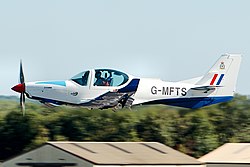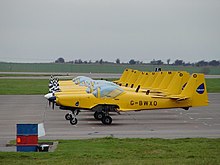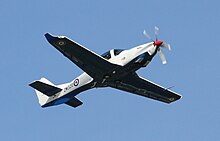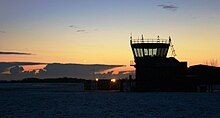| RAF Barkston Heath | |||||||||||
|---|---|---|---|---|---|---|---|---|---|---|---|
| Near Grantham, Lincolnshire in England | |||||||||||
 A Grob Prefect T1 based at Barkston Heath A Grob Prefect T1 based at Barkston Heath | |||||||||||
 | |||||||||||
| Coordinates | 52°57′44″N 000°33′42″W / 52.96222°N 0.56167°W / 52.96222; -0.56167 | ||||||||||
| Type | Relief Landing Ground | ||||||||||
| Area | 224 hectares (550 acres) | ||||||||||
| Site information | |||||||||||
| Owner | Ministry of Defence | ||||||||||
| Operator | Royal Air Force | ||||||||||
| Controlled by | No. 22 Group (Training) | ||||||||||
| Condition | Operational | ||||||||||
| Site history | |||||||||||
| Built | 1938; 87 years ago (1938) | ||||||||||
| In use | 1938–1943 (Royal Air Force) 1943–1945 (US Army Air Force) 1945 – present (Royal Air Force) | ||||||||||
| Garrison information | |||||||||||
| Occupants | 57 Squadron | ||||||||||
| Airfield information | |||||||||||
| Identifiers | ICAO: EGYE | ||||||||||
| Elevation | 111.8 metres (367 ft) AMSL | ||||||||||
| |||||||||||
| Source: UK MIL AIP Barkston Heath | |||||||||||
Royal Air Force Barkston Heath or RAF Barkston Heath (ICAO: EGYE) is a Royal Air Force Relief Landing Ground under the command of RAF Cranwell near Grantham, Lincolnshire, England.
RAF Barkston Heath is the home of 57 Sqn's B Flight of No. 3 Flying Training School RAF (3 FTS). For a period between approximately 1995 and 2010, it operated the Slingsby T67M260 Firefly, followed by the Grob Tutor T.1 operated between 2010 and 2018.
No. 3 FTS currently provide elementary flying training for RAF and Royal Navy students on the Grob Prefect T.1. A secondary role of RAF Barkston Heath is as a Relief Landing Ground for the flying training activities at RAF Cranwell.
History
Barkston Heath was constructed in 1936 and was initially used as a satellite station for RAF Cranwell.
United States Army Air Forces use

In late 1943, Barkston Heath was made available to the United States Army Air Force's Ninth Air Force. It was earmarked for basing troop carrier units scheduled to be transferred from Sicily to participate in the forthcoming cross-Channel invasion, Operation Overlord. During its time as a USAAF airfield, Barkston Heath was designated as USAAF station 483.
61st Troop Carrier Group
The first US personnel arrived on 13 February from Sciacca, Sicily, and most of their Douglas C-47 Skytrains on the 17th and 18th, although not all aircraft were in place until a month later. These new occupants were the 61st Troop Carrier Group.
The 61st TCG was part of the 52nd Troop Carrier Wing, IX Troop Carrier Command. The headquarters of the 61st Troop Carrier Group moved to an Advanced Landing Ground (ALG) at Abbeville (ALG B-92), France, on 13 March 1945, but its squadrons went to RAF Chipping Ongar from where they participated in Operation Varsity on 24 March carrying British paratroops who dropped near Wesel.
349th Troop Carrier Group
An increased demand for theatre air transport brought the 349th TCG from Baer Field, Indiana in late March 1945, with its Curtiss C-46 Commando transports. Group headquarters was established at Barkston on 30 March, but the group only remained three weeks before moving to Rove/Amy, France, on 18 April.
Royal Air Force use
The USAAF returned control of the airfield to the Air Ministry in June 1945 when the war in Europe ended. From 1983 to 1989 Barkston was home to 'A' Flight 25 Squadron (with Bristol Bloodhound surface-to-air missiles) when they returned from RAF Bruggen in Germany.
Elementary Flying Training

On 1 April 1995, the Joint Elementary Flying Training School (JEFTS), which provided training to RAF and Fleet Air Arm (FAA) pilots, relocated to Barkston Heath from RAF Topcliffe in North Yorkshire. The school was equipped with eighteen civilian registered Slingsby T67M Firefly trainer aircraft.
In 1996 the Army Air Corps (AAC) joined JEFTS and the school operated as a tri-service organisation until 2003 when the RAF decided to instead provide elementary flying training through its network of University Air Squadrons. JEFTS as a result was renamed the Defence Elementary Flying Training School in July 2003, with the FAA element re-establishing itself as 703 Naval Air Squadron (703 NAS) and the AAC element as No. 674 Squadron.
In November 2009 the Fireflies were retired and replaced with the Grob Tutor T.1.
In April 2021, No. 674 Squadron was stood-down as ACC pilots will no longer be trained on the Prefect prior to rotary wing training at RAF Shawbury.
Other units
The following units were also here at some point:
- No. 1 Elementary Flying Training School RAF
- No. 2 Central Flying School RAF
- No. 2 Flying Instructors School RAF
- No. 3 (Coastal) Operational Training Unit RAF
- No. 7 Equipment Disposal Depot RAF
- No. 85 Squadron RAF
- RAF College
- RAF College Flying Training School RAF
- RAF College Service Flying Training School RAF
Infrastructure and facilities

The RAF Barkston Heath site extends to 224 hectares (550 acres). It has three runways, 06/24 which is 1,868 metres (6,129 ft) long, 10/28 which is 1,319 metres (4,327 ft) long and 18/36 which is 1,280 metres (4,199 ft) long, all constructed from asphalt.
The airfield has limited facilities and relies on its parent station RAF Cranwell for support. The main building at Barkston Heath is the Operational Support Building which was re-opened in January 2018 after refurbishment as part of the UK Military Flying Training System (UKMFTS) programme. It was renamed the Esmonde Building in memory of Lieutenant Commander Eugene Esmonde, a distinguished Fleet Air Arm pilot who was a posthumous recipient of the Victoria Cross.
Out of six T2 type hangar and one B1 type constructed during the Second World War, only two T2 type remain on the site.
The airfield contains the decaying remains of an English Electric Canberra at the northern edge of the airfield site.
Role and operations
Defence Elementary Flying Training School

RAF Barkston Heath is home to the Defence Elementary Flying Training School, comprising 57 Squadron RAF, operating the Grob Prefect T1 in the elementary flying training role. Aircraft and support are provided by a civilian contractor, Ascent Flight Training, as part of the UK Military Flying Training System contract. Ascent also provides a significant proportion of the instructional staff, the Air Traffic Control service is provided by NATS Solutions Ltd, Affinity provide engineering personnel and other Station support personnel are provided by NBC and the MoD.
Although the school trains Fleet Air Arm crews, it is under the command of the RAF's No. 3 Flying Training School, based at nearby RAF Cranwell.
703 Naval Air Squadron
703 NAS trains Fleet Air Arm pilots destined to fly both rotary (AgustaWestland Merlin and AgustaWestland Wildcat) and fixed wing aircraft (Lockheed Martin F-35B II Lightning and BAE Hawk). Helicopter students graduate to No. 1 Flying Training School (1 FTS) at RAF Shawbury in Shropshire, whereas fast jet students move onto No. 4 Flying Training School at RAF Valley in Anglesey.
Relief Landing Ground
Barkston Heath acts as a Relief Landing Ground for the flying training activities at RAF Cranwell, which is four minutes flying time away.
Based units

The following flying units are based at RAF Barkston Heath. The station is also regularly used as relief landing ground by aircraft based at nearby RAF Cranwell.
Royal Air Force
- No. 3 Flying Training School / Defence Elementary Flying Training School
See also
References
![]() This article incorporates public domain material from the Air Force Historical Research Agency
This article incorporates public domain material from the Air Force Historical Research Agency
Citations
- ^ "Defence Estates Development Plan 2009 – Annex A". GOV.UK. Ministry of Defence. 3 July 2009. p. 18. Retrieved 14 September 2023.
- "UK MIL AIP Barkston Heath" (PDF). UK Military AIP. No.1 Aeronautical Information Documents Unit. 22 April 2021. Retrieved 9 August 2021.
- ^ "RAF Barkston Heath". Bomber County Aviation Resource. Retrieved 24 November 2021.
- "61st Troop Carrier Group". American Air Museum in Britain. Retrieved 24 November 2021.
- "349th Troop Carrier Group". American Air Museum in Britain. Retrieved 24 November 2021.
- March, Peter R. (1998). Brace by Wire to Fly-by-Wire – 80 Years of the Royal Air Force 1918–1988. RAF Fairford: RAF Benevolent Fund Enterprises. p. 164. ISBN 1-899808-06-X.
- ^ "Flight of the Slingsby Firefly". BBC News. 17 November 2009. Retrieved 18 April 2019.
- ^ "Fleet Air Arm | 703 Naval Air Squadron | Elementary Flying Training". Royal Navy. Retrieved 16 April 2019.
- "Recently, a ceremony was held at RAF Barkston Heath to mark the standing down of No 674 Squadron Army Air Corps (AAC)". Royal Air Force. 30 April 2021.
- "Barkston Heath". Airfields of Britain Conservation Trust. Retrieved 24 February 2017.
- "UK MIL AIP Barkston Heath" (PDF). UK Military AIP. No.1 Aeronautical Information Documents Unit. 3 January 2019. Retrieved 14 April 2019.
- "Cutting-edge milestone for UKMFTS programme" (PDF). Desider. 115. Ministry of Defence / Defence Equipment & Support: 12. February 2018.
- Historic England. "RAF Barkston Heath (1383736)". Research records (formerly PastScape). Retrieved 8 May 2019.
- "Google maps". Retrieved 18 May 2022.
- "UK military flying training hits news highs | MOD-DCO". www.contracts.mod.uk. Retrieved 24 April 2020.
- ^ "RAF College Cranwell". Royal Air Force. Retrieved 16 April 2019.
Bibliography
- Bruce Barrymore Halpenny Action Stations: Wartime Military Airfields of Lincolnshire and the East Midlands v. 2 (ISBN 978-0850594843)
- Freeman, Roger A. (1994) UK Airfields of the Ninth: Then and Now 1994. After the Battle ISBN 0-900913-80-0
- Freeman, Roger A. (1996) The Ninth Air Force in Colour: UK and the Continent-World War Two. After the Battle ISBN 1-85409-272-3
- Maurer, Maurer (1983). Air Force Combat Units of World War II. Maxwell AFB, Alabama: Office of Air Force History. ISBN 0-89201-092-4.
External links
- Royal Navy – Elementary Flying Training
- UK Military Aeronautical Information Publication – Barkston Heath (EGYE)
| Royal Air Force | |||||||
|---|---|---|---|---|---|---|---|
| Ministry of Defence | |||||||
| formations and units |
| ||||||
| branches and components | |||||||
| reserve forces | |||||||
| equipment | |||||||
| personnel | |||||||
| appointments | |||||||
| symbols and uniform | |||||||
| associated civil organisations | |||||||
| Active Royal Air Force stations | |||||||||||||||
|---|---|---|---|---|---|---|---|---|---|---|---|---|---|---|---|
| United Kingdom |
| ||||||||||||||
| overseas |
| ||||||||||||||
| Army Air Corps (units) | |||||||||||
|---|---|---|---|---|---|---|---|---|---|---|---|
| Airfields | |||||||||||
| Regular units |
| ||||||||||
| Army reserve units |
| ||||||||||
| Training units |
| ||||||||||
| Other |
| ||||||||||
| Independent squadrons | |||||||||||
| Former display units |
| ||||||||||
| active stations |  | |
|---|---|---|
| active air weapons ranges | ||
| former stations |
| |
